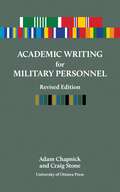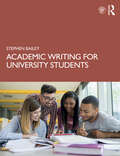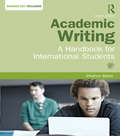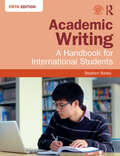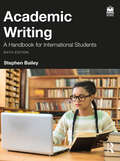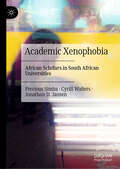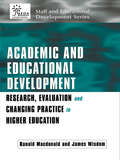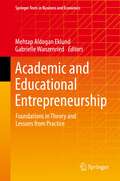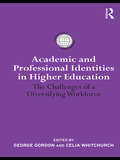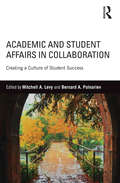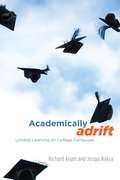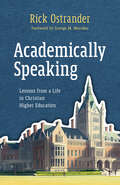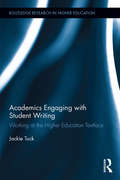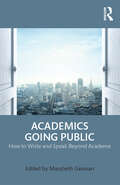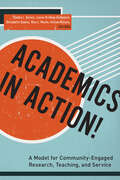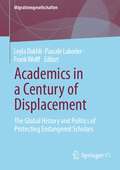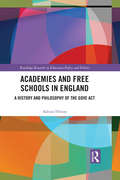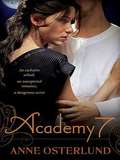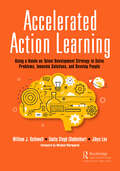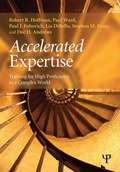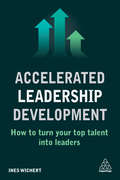- Table View
- List View
Academic Writing for Military Personnel, revised edition: Revised Edition (Standalone titles)
by Adam Chapnick Craig StoneAcademic Writing: A Guide for Military Personnel est un manuel de rédaction conçu pour aider le personnel militaire à rédiger des travaux savants dans un style clair et efficace. Fruit de la collaboration entre un professeur d’écriture chevronné et un officier militaire à la retraite, le manuel s’adresse aux membres des forces armées qui rejoignent le monde universitaire et qui ont déjà rédigé dans un contexte professionnel militaire ou qui n’ont aucune expérience de la rédaction. En plus d’enseigner aux officiers comment rédiger efficacement, cet ouvrage explique en quoi la maîtrise des techniques de rédaction est utile au personnel des forces armées dans leurs tâches régulières, en particulier aux échelons supérieurs. L’ouvrage traite de l’importance de savoir communiquer par écrit, de ce qui distingue la rédaction savante de la rédaction professionnelle, des processus de recherche et de rédaction proprement dite, du professionnalisme dans la sphère universitaire ainsi que des problèmes et défis fréquemment rencontrés par les rédactrices et les rédacteurs. Un dernier chapitre novateur traite de la manière dont les officiers peuvent mettre à profit les connaissances qu’ils ont acquises par leurs expériences professionnelles dans le contexte universitaire. Des exemples concrets — à l’usage particulier des militaires — sont présentés tout au long du texte pour guider la lectrice et le lecteur de manière pratique et pertinente.Cette édition révisée comprend de nouveaux exemples provenant d’une plus grande variété d’auteurs. Elle prend en compte l’évolution récente des technologies de communication et reflète les nouvelles avancées dans les domaines de l’enseignement et de l’apprentissage.Cet ouvrage, qui est le seul guide exhaustif sur la rédaction à l’usage du personnel militaire, est un ajout incontournable à la bibliothèque de tout officier militaire où qu’il se trouve et quel que soit son rang.Ce livre est publié en anglais. Note : Une version française de ce livre sera disponible en 2023.Formats disponibles : couverture souple, PDF accessible et ePub accessible
Academic Writing for University Students
by Stephen BaileyAcademic Writing for University Students is designed to help all students succeed in writing essays, reports and other papers for coursework and exams effectively. Academic writing is often the biggest challenge facing college and university students, but this book provides all the tools needed to master the necessary skills. The book is divided into four parts, to help teachers and students easily find the help they need, both in the classroom and for self-study: The Writing Process: From finding suitable sources, through to editing and proofreading Writing Types: Practice with common assignments such as reports and cause-effect essays Writing Tools: Skills such as making comparisons, definitions, punctuation and style Lexis: Academic vocabulary, using synonyms, nouns, adjectives, verbs and adverbs This key handbook breaks down and practises every stage of essay writing. All units are fully cross-referenced, and a complete set of answers to the practice exercises is included. In addition, the companion website hosts comprehensive teaching notes as well as more challenging exercises, revision material and links to other sources. Designed for self-study as well as classroom use, this book uses authentic academic texts from a range of sources and provides models for common writing tasks such as case studies, while progress checks are included for each part to enable students to assess their learning. Academic Writing for University Students is an invaluable guide to all aspects of academic writing in English.
Academic Writing: A Handbook for International Students
by Stephen BaileyMost international students need to write essays and reports for exams and coursework, but writing good academic English is one of the most demanding tasks students face. This new, fourth edition of Academic Writing: A Handbook for International Students has been completely revised to help students reach this goal. The four main parts of Academic Writing are: The writing process Elements of writing Vocabulary for writing Writing models Each part is divided into short units which contain examples, explanations and exercises, for use in the classroom or for self-study. The units are clearly organised to allow teachers and students find the help they need with writing tasks, while cross-referencing allows easy access to relevant sections. In the first part, each stage of the writing process is demonstrated and practised, from selecting suitable sources, reading, note-making and planning through to re-writing and proof-reading. The fourth edition of this popular course builds on the success of the earlier editions, and has a special focus on the vital topic of academic vocabulary in part three, Vocabulary for Writing. Part three deals with areas such as nouns and adjectives, adverbs and verbs, synonyms, prefixes and prepositions, in an academic context. More key features of the book include: All elements of writing are clearly explained, with a full glossary for reference Models provided for all types of academic texts: essays, reports, reviews and case-studies Full range of practice exercises, with answer key included Use of authentic academic texts A companion website offers further practice with a range of additional exercises Fully updated, with sections on finding electronic sources and evaluating internet material All international students wanting to maximise their academic potential will find this practical and easy-to-use book an invaluable guide to writing in English for their degree courses.
Academic Writing: A Handbook for International Students
by Stephen BaileyNow in its fifth edition, Academic Writing helps international students succeed in writing essays and reports for their English-language academic courses. Thoroughly revised and updated, it is designed to let teachers and students easily find the topics they need, both in the classroom and for self-study.The book consists of five parts: The Writing Process Elements of Writing Language Issues Vocabulary for Writing Writing Models The first part explains and practises every stage of essay writing, from choosing the best sources, reading and note-making, through to referencing and proofreading. The four remaining parts, organised alphabetically, can be taught in conjunction with the first part or used on a remedial basis. A progress check at the end of each part allows students to assess their learning. All units are fully cross-referenced, and a complete set of answers to the practice exercises is included.New topics in this edition include Writing in Groups, Written British and American English, and Writing Letters and Emails. In addition, the new interactive website has a full set of teaching notes as well as more challenging exercises, revision material and links to other sources. Additional features of the book include: Models provided for writing tasks such as case studies and essays Use of authentic academic texts from a wide range of disciplines Designed for self-study as well as classroom use Useful at both undergraduate and postgraduate level Glossary to explain technical terms, plus index Written to deal with the specific language issues faced by international students, this practical, user-friendly book is an invaluable guide to academic writing in English.
Academic Writing: A Handbook for International Students
by Stephen BaileyThe new sixth edition of this popular book has been written to help international students succeed in writing essays and reports for their English-language academic courses. Thoroughly revised and updated in a streamlined format making it even easier for students and teachers to use, Academic Writing: A Handbook for International Students is designed to let readers find the support they need easily, both in the classroom and for self-study.The book consists of three parts, comprising a total of 28 units: The Writing Process and Writing Skills; Elements of Writing; and Writing Models. The first part explains and practises every stage of essay writing, from choosing the best sources, reading and note-making, through to referencing and proofreading. These stages are supported by relevant explanations of critical writing skills, so that, for instance, finding synonyms is linked with paraphrasing and summarising. The second part explains critical issues such as using numbers and punctuation, and is organised alphabetically, while the third part provides models for common components of student writing such as case studies and reports. All units are fully cross-referenced and can be taught in conjunction with each other or used for self-study or reference. A progress check at the end of each part allows students to self-assess their learning, and a complete set of answers to the practice exercises is included.Additional features of the book include: Use of authentic academic texts from a wide range of disciplines Designed for self-study as well as classroom use Useful at both undergraduate and postgraduate level Fully updated, with sections on using AI and exploring electronic sources Access to the free interactive website which includes a full set of teaching notes as well as more challenging exercises, revision material and links to other sources. All international students wanting to maximise their academic potential will find this practical and easy-to-use book an invaluable guide to writing in English for their degree courses.
Academic Xenophobia: African Scholars in South African Universities
by Jonathan D. Jansen Precious Simba Cyrill WaltersThis book explores the layered experiences of Black African faculty members at the 26 public universities in South Africa. Through rich narrative case studies and detailed policy analysis, the authors examine the manifestations of xenophobia within the academic context, including its impact on individuals, institutions, and policies. The book will be valuable to scholars, policymakers, and practitioners interested in understanding the evolving landscape of xenophobia, tertiary education, and immigration in South Africa.
Academic and Educational Development: Research, Evaluation and Changing Practice in Higher Education (SEDA Series)
by James Wisdom Ranald MacdonaldPart of the well-known Staff and Educational Development Series, this practice oriented book brings together leading research and evaluation approaches and supporting case studies from leading educational researchers and innovative teachers.With much emphasis on change, innovation and developing best practice in higher education, it is essential that those involved in actually developing, researching or implementing approaches to teaching, learning or management, are informed by the experiences of others. The emphasis of this book is on changing practice in HE; how developments come about; what research underpins desirable development; and the impact of development of student learning, staff expertise and institutional practice and policy. Specifically, the book is developed in two themed parts: Part A, Supporting change within subjects and departments. Part B, Supporting change within institutions and the wider environment.
Academic and Educational Entrepreneurship: Foundations in Theory and Lessons from Practice (Springer Texts in Business and Economics)
by Mehtap Aldogan Eklund Gabrielle WanzenriedThe editors and authors of this textbook introduce the relatively new subject of “academic and educational entrepreneurship” from a holistic viewpoint. Following a structured approach suitable for the classroom, the book opens with a concise introduction to the theories and schools of thoughts in the context of academic and educational entrepreneurship. It then reveals seven scientifically developed key aspects (including sustainability, internationalization, and cultural components) in order to be a successful academic and educational entrepreneur. After the theoretical background, the authors, who are the doyens of academic and educational entrepreneurship, share their insights and professional experiences with the readers by demonstrating the impact and relevance of the theoretical concepts to the actual entrepreneurial experience.
Academic and Professional Identities in Higher Education: The Challenges of a Diversifying Workforce (International Studies in Higher Education)
by George Gordon Celia WhitchurchThe latest volume in the Routledge International Studies in Higher Education Series, Academic and Professional Identities in Higher Education: The Challenges of a Diversifying Workforce, reviews the implications of new forms of academic and professional identity, which have emerged largely as a result of a broadening disciplinary base and increasing permeability between higher education and external environments. The volume addresses the challenges faced by those responsible for the wellbeing of academic faculty and professional staff. International perspectives examine current practice against a background of rapidly changing policy contexts, focusing on the critical ‘people dimension’ of enhancing academic and professional activity, while also addressing national, socio-economic, and community agendas. Consideration is given to mainstream academic faculty and professional staff, researchers, library and information professionals, people with an interest in teaching and learning, and those involved in individual projects or institutional development. The following provide the key themes of Academic and Professional Identities in Higher Education: The Challenges of a Diversifying Workforce: The implications of diversifying academic and professional identities for the functioning of higher education institutions and sectors. The pace and nature of such change in different institutional systems and environments. The challenges to institutional systems and structures from emergent identities and possible tensions, and how these might be addressed. The implications of blurring academic and professional identities, with a shift towards mixed or ‘blended’ roles, for individual careers and institutional development.
Academic and Student Affairs in Collaboration: Creating a Culture of Student Success
by Mitchell A. Levy Bernard A. PolnarievAcademic and Student Affairs in Collaboration provides a comprehensive and evidenced-based understanding of the partnerships necessary to achieve an institutional culture devoted to student success. Chapter authors explore how to design, implement, and assess collaborative efforts between student and academic affairs in support of increased student success. This book provides best practices for fostering and enhancing campus dialogue, career development pathways, academic support services, and other important initiatives to increase retention and learning outcomes, improve motivation and goal attainment, and enhance institutional accountability. This book is a must-read for scholars, faculty, leaders, and practitioners in Student Affairs and Higher Education interested in achieving student success at their universities and colleges.
Academically Adrift: Limited Learning on College Campuses
by Richard Arum Josipa RoksaIn spite of soaring tuition costs, more and more students go to college every year. A bachelor's degree is now required for entry into a growing number of professions. And some parents begin planning for the expense of sending their kids to college when they're born. Almost everyone strives to go, but almost no one asks the fundamental question posed by Academically Adrift: are undergraduates really learning anything once they get there? For a large proportion of students, Richard Arum and Josipa Roksa's answer to that question is a definitive no. Their extensive research draws on survey responses, transcript data, and, for the first time, the state-of-the-art Collegiate Learning Assessment, a standardized test administered to students in their first semester and then again at the end of their second year. According to their analysis of more than 2,300 undergraduates at twenty-four institutions, 45 percent of these students demonstrate no significant improvement in a range of skills--including critical thinking, complex reasoning, and writing--during their first two years of college. As troubling as their findings are, Arum and Roksa argue that for many faculty and administrators they will come as no surprise--instead, they are the expected result of a student body distracted by socializing or working and an institutional culture that puts undergraduate learning close to the bottom of the priority list. Academically Adrift holds sobering lessons for students, faculty, administrators, policy makers, and parents--all of whom are implicated in promoting or at least ignoring contemporary campus culture. Higher education faces crises on a number of fronts, but Arum and Roksa's report that colleges are failing at their most basic mission will demand the attention of us all.
Academically Speaking: Lessons from a Life in Christian Higher Education
by Rick OstranderA personal odyssey through the world of Christian higher education, narrated by a professional who has worked on both sides of the faculty-administrative divide. What is the world of Christian higher education really like? Rick Ostrander&’s thirty-year career in Christian academia equips him to provide an insider&’s perspective on the field and its future. Ostrander cut his teeth as an undergraduate at Moody Bible Institute and the University of Michigan before completing his PhD with George Marsden at Notre Dame. From there he worked as a professor and administrator at various Christian colleges, a vice president at the Council for Christian Colleges and Universities, and an independent academic consultant. Throughout, he witnessed the many dramatic transformations of Christian higher education. Ostrander traces an attempt to cultivate evangelical intellectualism in the &’90s to the political and economic forces that shake Christian colleges today. Through lively storytelling, Ostrander highlights the qualities and quirks of Christian higher education. His experiences offer readers insight into how Christian colleges can flourish in an age of uncertainty.
Academics Engaging with Student Writing: Working at the Higher Education Textface (Routledge Research in Higher Education)
by Jackie TuckStudent writing has long been viewed as a problem in higher education in the UK. Moreover, the sector has consistently performed poorly in the National Student Survey with regard to assessment and feedback. Academics Engaging with Student Writing tackles these major issues from a new and unique angle, exploring the real-life experiences of academic teachers from different institutions as they set, support, read, respond to and assess assignments undertaken by undergraduate students. Incorporating evidence from post-1992 universities, Oxbridge, members of the Russell Group and others, this book examines working practices around student writing within the context of an increasingly market-oriented mass higher education system. Presenting a wealth of relevant examples from disciplines as diverse as History and Sports Science, Tuck makes extensive use of interviews, observations, texts and audio recordings in order to explore the perspectives of academic teachers who work with student writers and their texts. This book will be of interest to researchers, academics and postgraduate students in the fields of academic literacies, higher education, language and literacy, language in higher education, English for academic purposes and assessment. Furthermore, academic teachers with experience of this crucial aspect of academic labour will welcome Tuck’s pioneering work as an indispensable tool for making sense of their own engagement with student writers.
Academics Going Public: How to Write and Speak Beyond Academe
by Marybeth GasmanAcademics Going Public makes the case for academics to enter the public sphere and simultaneously gives them the tools to do so. This important book helps faculty members who want to become more active on a national scale and would like to move beyond publication in scholarly journals and books. Expert contributors explore how to have a voice about salient higher education issues and engage traditional media, new medias, policymakers, funders, and the general public. Chapters offer best approaches and concrete strategies for diverse audiences, helping faculty have an impact on society by becoming more publicly engaged and writing for broader audiences in more inclusive ways. This critical guide also covers strategies for confronting obstacles academics might encounter along the way and presents tactics for responding to controversy and backlash.
Academics in Action!: A Model for Community-Engaged Research, Teaching, and Service
by Lauren Brinkley-Rubinstein Bernadette Doykos Nina C. Martin Allison McGuireThe academy is often described as an ivory tower, isolated from the community surrounding it. Presenting the theory, vision, and implementation of a socially engaged program for the Department of Human and Organizational Development (HOD) in Peabody’s College of Education and Human Development at Vanderbilt University, Academics in Action! describes a more integrated model wherein students and faculty work with communities, learn from them, and bring to bear findings from theory and research to generate solutions to community problems.Offering examples of community-engaged theory, scholarship, teaching, and action, Academics in Action! describes the nuanced structures that foster and support their development within a research university. Theory and action span multiple ecological levels from individuals and small groups to organizations and social structures. The communities of engagement range from local neighborhoods and schools to arenas of national policy and international development.Reflecting the unique perspectives of research faculty, practitioners, and graduate students, Academics in Action! documents a specific philosophy of education that fosters and supports engagement; the potentially transformative nature of academic work for students, faculty, and the broader society; and some of the implications and challenges of action-oriented efforts in light of dynamics such as income inequality, racism, and global capitalism. This edited volume chronicles teaching, research, and community action that influences both inside and outside the classroom as well as presents dimensions of a participatory model that set such efforts into action.
Academics in a Century of Displacement: The Global History and Politics of Protecting Endangered Scholars (Migrationsgesellschaften)
by Frank Wolff Leyla Dakhli Pascale Laborier‘Endangered scholars’ is a recently highly relevant, yet historical notion. Embedded in the greater history of the 20th and 21st centuries, it captures the phenomenon of scholars who, after years of intellectual work and integration in their societies of origin, are forced to seek rescue in foreign host societies. The pressing urgency of the topic thus has an important historical background. From escaping Russian intellectuals after 1917 to the protection of Jewish refugees during World War II, Algerian intellectuals in contemporary history, or persecuted academics from Turkey today: Over the course of about a century, categories of inclusion, transnational relations, and forms of agency of scholars at risk remained surprisingly stable (and hence diachronously and synchronously comparable) while they also adjusted flexibly to contemporary conditions. This collective volume carves out this historical development and its recent expressions. It brings together researchers in a vivid yet largely unconnected field of migration and refugee studies. By developing a complex image of the origin of the global history and politics of protecting endangered scholars from the early 20th century until today, the book contributes to research on academics in exile as a part of refugee research, migration studies, the history of higher education, and the contemporary history of societies. The interdisciplinary volume explores the phenomenon as a historical, political and legal subject, brings together scholars of forced migration and intellectual studies, and includes currently affected scholars into those reflections.
Academies and Free Schools in England: A History and Philosophy of The Gove Act (Routledge Research in Education Policy and Politics)
by Adrian HiltonAcademies and Free Schools in England argues that there is a high degree of philosophical consensus and historical continuity on the policy of ‘academisation’ across the main political parties in England. It attempts to make sense of what are all essentially free schools by interviewing the architects of policy and their closest advisors, analysing the extent to which they invoke historical expressions of conservatism and/or liberalism in their articulation of that convergence. The book offers a unique insight into educational policy-making during the Conservative/Liberal-Democrat coalition era (2010-2015), and an in-depth analysis of the nature of liberty as it relates to state education in England. Providing original interview transcripts of the key reformers, and new accounts of a sometimes contentious history, Hilton identifies an elite ‘policy community’, connected by educational background, moral-religious frameworks, life experiences and shared networks of common ideology. Academies and Free Schools in England will be vital reading to academics and researchers in the field of education and education policy. It will also be of great interest to school governors, business leaders, political philosophers and those involved and interested in free schools.
Academies, Free Schools and Social Justice
by Geoffrey WalfordAcademies were introduced by Labour in 2000 and first opened their doors in 2002, but during Labour’s time in power the nature of the Academies changed. At first they were designed to replace existing failing schools but, by 2004, the expectation had widened to provide for entirely new schools where there was a demand for new places. From 2010, under the coalition government, two new types of Academy were introduced. While the original Academies were based on the idea of closing poor schools and replacing them by dramatically redesigned and restructured ones, the 2010 Academies Act allowed existing highly successful state-maintained schools to apply to become Academies as well. Further, while Labour had restricted Academy status to secondary schools, the Coalition extended it to primary and special schools. The result is that there has been a dramatic increase in the number and diversity of Academies. In addition to this, the 2010 Act introduced Free Schools, wherein groups of parents, teachers, or other sponsors can apply to start their own state-maintained, but officially ‘independent’, schools. These schools can either be completely new or the result of existing private schools applying to become state-maintained. The results of these changes remain under-researched. This book puts forward new research that examines the history and nature of Academies and Free Schools, the processes by which they have come into existence, and their effects in terms of social justice. The contributors do not all speak with one voice, but rather present a diversity of views on these important topics. Included in the collection are the results of research on pupil outcomes and socio-economic segregation; issues of identity and ethos in church academies; the problems of establishing free schools; the history of policy on Academies; and a comparison between Swedish independent schools and Academies and Free Schools. This book was originally published as a special issue of Research Papers in Education.
Academy 7
by Anne OsterlundWith a past too terrible to speak of, and a bleak, lonely future ahead of her, Aerin Renning is shocked to find she has earned a place at the most exclusive school in the universe. Aerin excels at Academy 7 in all but debate, where Dane Madousin?son of one of the most powerful men in the Alliance? consistently outtalks her. Fortunately Aerin consistently outwits him at sparring. They are at the top of their class until Dane jeopardizes everything and Aerin is unintentionally dragged down with him. When the pair is given a joint punishment, an unexpected friendship?and romance?begins to form. But Dane and Aerin both harbor dangerous secrets, and the two are linked in ways neither of them could ever have imagined. . . . .
Academy Dictionaries 1600-1800
by John ConsidineThis is the first unified history of the large, prestigious dictionaries of the seventeenth and eighteenth centuries, compiled in academies, which set out to glorify living European languages. The tradition began with the Vocabolario degli Accademici della Crusca (1612) in Florence and the Dictionnaire de l'Académie françoise (1694) in Paris, and spread across Europe - to Germany, Spain, England, Denmark, Sweden, the Netherlands, Portugal, and Russia - in the eighteenth century, engaging students of language as diverse as Leibniz, Samuel Johnson, and Catherine the Great. All the major academy and academy-style dictionaries of the period up to 1800, published and unpublished, are discussed in a single narrative, bridging national and linguistic boundaries, to offer a history of lexicography on a European scale. Like John Considine's Dictionaries in Early Modern Europe (Cambridge University Press, 2008), this study treats dictionaries both as physical books and as ambitious works of the human imagination.
Academy Seven
by Anne OsterlundAerin Renning and Dane Madousin struggle as incoming students at the most exclusive academy in the Universe, both hiding secrets that are too painful to reveal, not realizing that those very secrets link them together.
Accelerated Action Learning: Using a Hands-on Talent Development Strategy to Solve Problems, Innovate Solutions, and Develop People
by William J. Rothwell Jihye Lee Smita Singh (Dabholkar)In a knowledge-based society, people should not simply collect knowledge but should utilize and apply it to solve a problem. Action learning makes organizational members learn while solving real problems in the workplace. However, traditional action learning might not be effective for rapidly changing environments, because it is typically a process that requires substantial time. Therefore, this book provides a guideline on how to apply action learning quickly in workplaces—especially in virtual settings. Action learning allows the organization to develop people while, at the same time, getting work done. It is an alternative to classroom-based and online learning programs. In addition, it can also be an alternative to the instructional systems design (ISD) model or the successive approximation model (SAM) as a means of developing planned instruction if used for that purpose. Action learning can be an effective tool for Web 2.0 learning. Many organizations are now using self-directed teams and other team formats for work. It makes sense to revisit planned on-the-job training and learning with an emphasis on teams. Action learning is a process involving a small group with facilitators and action-learning process managers, so it is one of the best options for team-based problem-solving. This book provides real action learning cases. There are needs that have emerged in these post-pandemic times. There is a need to explain how action learning can be applied to various settings, issues, and challenges. Since COVID-19 occurred, many people must work in virtual or hybrid settings. This book gives trainers—who could be HR managers, operating managers, or learning and development professionals—guidelines that can be used in virtual settings to meet the new needs. Essentially, this book is written for team facilitators, supervisors, managers, or team members who wish to plan action-oriented, problem-based, and work-related learning experiences in real time. Because many action-learning books are written for an academic audience, it is not easy to put action learning into practice. Therefore, the goal of this book is to provide guidelines on how action learning starts, what basic principles should be considered, and what tools and techniques are needed for rapid action learning. The book is intended to be a primer on how to facilitate a planned learning project in a team or workgroup.
Accelerated Expertise: Training for High Proficiency in a Complex World (Expertise: Research and Applications)
by Paul Ward Robert R. Hoffman Paul J. Feltovich Lia DiBello Stephen M. Fiore Dee H. AndrewsSpeed in acquiring the knowledge and skills to perform tasks is crucial. Yet, it still ordinarily takes many years to achieve high proficiency in countless jobs and professions, in government, business, industry, and throughout the private sector. There would be great advantages if regimens of training could be established that could accelerate the achievement of high levels of proficiency. This book discusses the construct of ‘accelerated learning.’ It includes a review of the research literature on learning acquisition and retention, focus on establishing what works, and why. This includes several demonstrations of accelerated learning, with specific ideas, plans and roadmaps for doing so. The impetus for the book was a tasking from the Defense Science and Technology Advisory Group, which is the top level Science and Technology policy-making panel in the Department of Defense. However, the book uses both military and non-military exemplar case studies.
Accelerated Leadership Development: How to Turn Your Top Talent into Leaders
by Ines WichertAs organizations adapt to an increasingly volatile and complex world, it is crucial that HR and Learning and Development (L&D) professionals ensure that leadership development keeps pace and employees have the right skills and capabilities to operate successfully in leadership positions. Accelerated Leadership Development shows how organisations can accelerate the career progression of their top talent and reduce the journey time from entry level to senior executive roles. It covers the entire acceleration process from how to identify which individuals are right for accelerated leadership development, to what roles are best suited for stretch assignments, and how to avoid burnout. Packed with insights from HR experts and business leaders from across the globe, Accelerated Leadership Development shows how this type of development works in practice, what makes it successful and highlights the potential pitfalls to look out for. Debunking the myth that one size of leadership development fits all, this book includes specific guidance on how to tailor leadership development to women and millennials. Full of practical advice, tips and techniques, this is an essential book for anyone looking to develop their very best employees.
Accelerated Learning for the 21st Century
by Colin RoseWe live in an era when the unprecedented speed of change means: The only certainty is uncertainty; you can't predict what skills will be useful in ten years time; in most professions knowledge is doubling every two or three years; and no job is forever--so being employable means being flexible and retraining regularly.Accelerated Learning into the 21st Century contains a simple but proven plan that delivers the one key skill that every working person, every parent and student must master, and every teacher should teach: it's learning how to learn. The theory of eight multiple intelligences (linguistic, logical-mathematical, visual-spatial, kinesthetic, musical, interpersonal, intrapersonal, and naturalist) developed by Howard Gardner at Harvard University provides a foundation for the six-step MASTER-Mind system to facilitate learning (an acronym for Mind, Acquire, Search, Trigger, Exhibit, and Review), and is enhanced by the latest findings on the value of emotion and memory on the process of learning.Combined with motivational stories of success applying these principles, and putting forth a clear vision of how the United States can dramatically improve the education system to remain competitive in the next century, Accelerated Learning into the 21st Century is a dynamic tool for self-improvement by individuals as diverse as schoolchildren and corporate executives.From the Trade Paperback edition.
